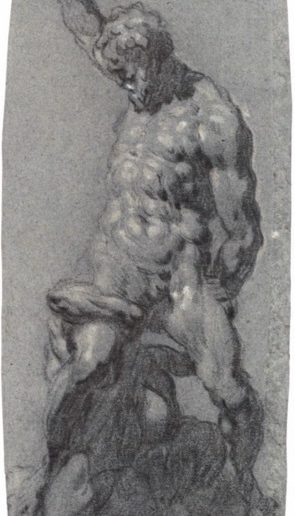Jacopo Tintoretto
Study after Michelangelo’s Samson and Two Philistines
Ca. 1550-1555
Soft black chalk, highlighted with white gouache, on blue paper
38.6 x 16.4 cm
On loan from the Tobey Collection
This is a study rendered by Jacopo Tintoretto depicting a lost sketch-model of a sculpture of Samson and the Philistines by Michelangelo, an artist who had a great deal of influence on 16th century Italian art in general, and on Tintoretto in particular. Tintoretto’s family name was Robusti, but his nickname derives from the profession of his father, who was a dyer or “Tintore.” He seems to have lived the majority of his life in Venice, where he completed most of his works. It is useful to see such small works by Tintoretto, as he is most famous for rendering quite large narratives on canvas.
Tintoretto is often called a Mannerist, whose stylistic characteristics include human forms in exaggerated poses and use of other dramatic elements of line, space, or lighting. Given these preoccupations, we can see why Tintoretto would be attracted to Michelangelo’s art. Here we see the powerfully-muscled frontal figure of Samson standing over his crouching enemies. He twists his torso, turns his head, and raises his right arm, pivoting from the waist to smite the Philistine reaching up to grasp his thigh. The scene is enhanced by the use of inky shadows and white highlights, suggesting intense, dramatic light. The appeal of this sculpture study by Michelangelo is attested to by the fact that more than thirty sketches of it exist, all created by Tintoretto or his students and assistants.
Bryant Davis

